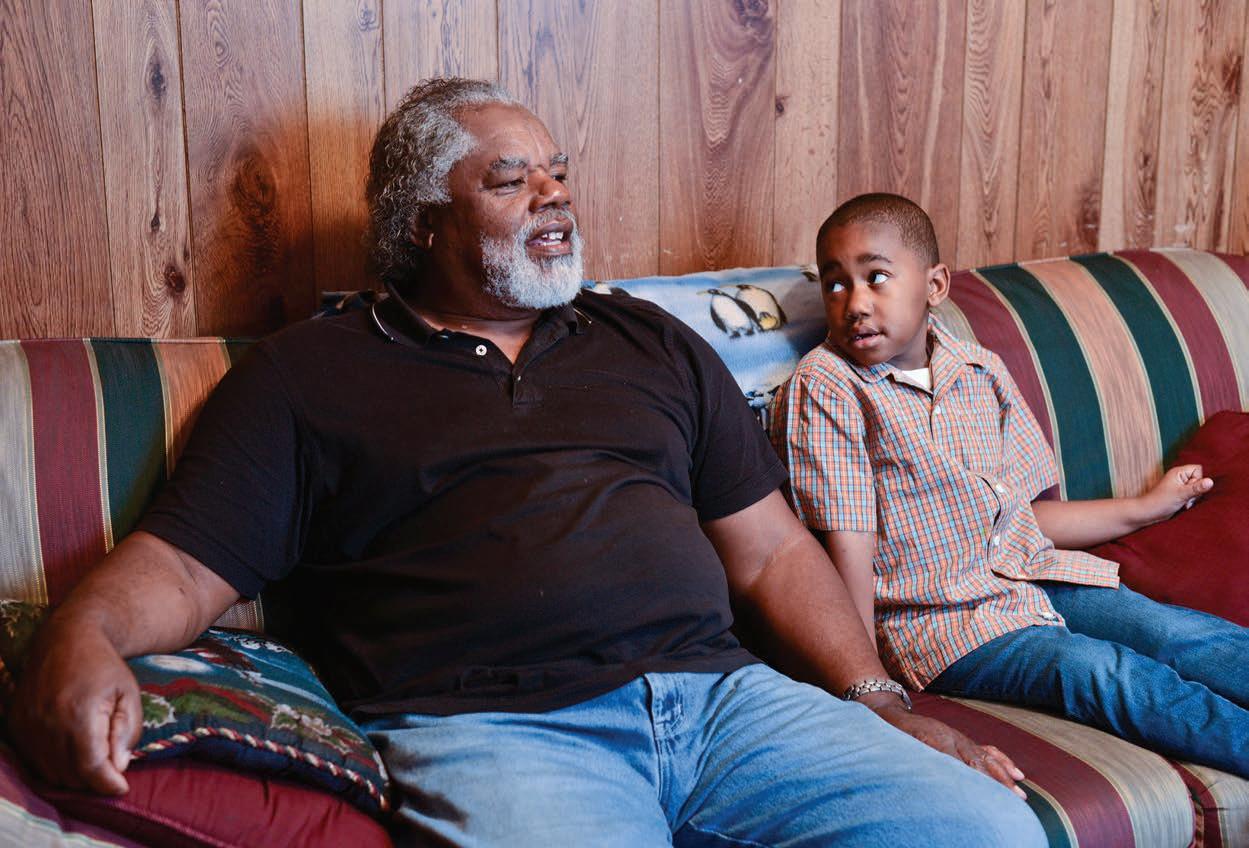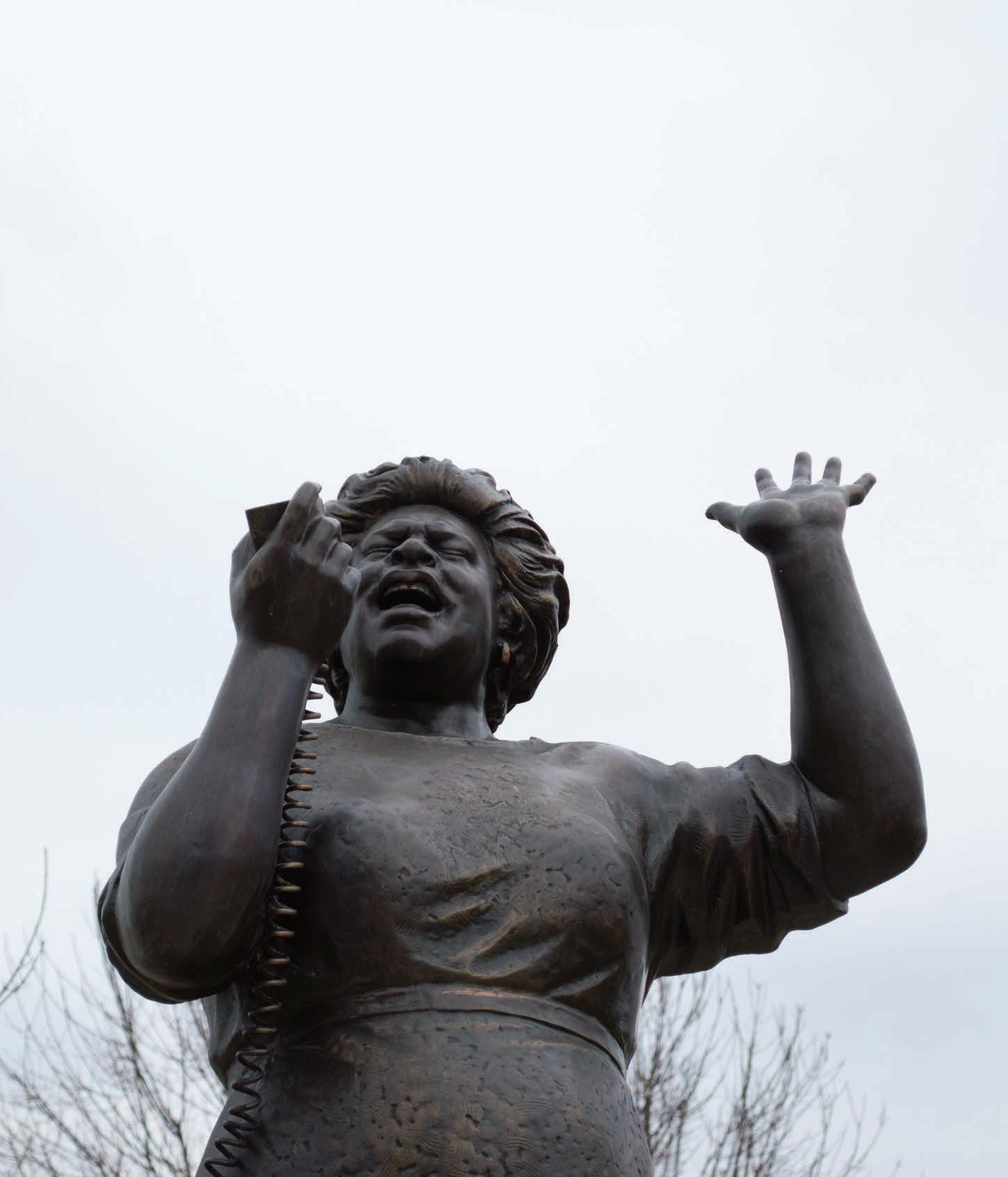
9 minute read
Sick and Tired of Being Sick And Tired
FANNIE LOU HAMER

Hamer testifies at a committee hearing. PHOTO BY ASSOCIATED PRESS
She trudged into the “bullpen,” a cell in Mississippi’s voters, traveled to the Delta. Hamer decided to attend Montgomery County Jail. Forced to lie face one of their meetings. When they called for volunteers down, the 45-year-old Delta plantation worker to be among the first group to try to register, Hamer heard what the Highway Patrol officers said: was the first to volunteer. She no longer wanted to be “We’re going to make you wish you were dead.” just a sharecropper in Sunflower County. She wanted
Two black prisoners stood off to the side. The something more. She wanted to make a difference. cops handed them a black-jack and told them to At one point in the long struggle, Hamer pummel the civil rights worker, threatening to beat called for action in her typically blunt way. them if they didn’t. So the first prisoner beat her until “It’s one thing, it’s one thing I don’t want you to he was exhausted – then the second took over. say tonight after I finish — and it won’t be long—I
Fannie Lou Hamer was beaten until her body burned, don’t want to hear you say, ‘Honey, I’m behind you.’ until she couldn’t bend her fingers, until she couldn’t “Well, move. I don’t want you back there. Because you move. Then they dragged her back to her cell and could be 200 miles behind. I want you to say, ‘I’m with left her, battered and bleeding. When she was finally you. And we’ll go up this freedom road together.” released, she learned that Medgar Evers – the spiritual In August 1962, Hamer and 17 others took that road leader of Mississippi’s civil rights movement – had to Indianola in their first attempt to register. When they been assassinated in his front yard, in front of his wife pulled up to the courthouse steps, there were white and three young children. men waving guns, shouting
That June 1963 beating “niggers, niggers.” So Hamer would not be the last time Hamer endured tragedy and “We didn’t come for began singing “This Little Light of Mine” to bolster the resolve hardships in her long struggle for civil rights. In fact, the beating no two seats when all of her comrades. It worked. The music filled the bus, taking that she never recovered from happened months after she of us is tired” the focus away from the fear of being stopped. For the rest joined the movement. By then, of the civil rights movement, Hamer had tried to register to –– FANNIE LOU HAMER for the rest of her life, the vote, lost her plantation job of song became her anthem. 18 years, attended a Student “She wanted everyone to Non-Violent Coordinating Committee (SNCC) rally and see what she was doing for civil rights,” said Jimmy had become a dynamic force in the fight for equality. Lacy, Hamer’s nephew. “She made sure the world
Before that fight ended, Hamer would become a knew what was happening. She always said the light household name, not only in her Delta hometown was her life, shining on the events taking place.” of Ruleville, but also in homes across the nation. Hamer had seen the light several times before. After A sharecropper with a 6th-grade education, she the trip to Indianola, her white plantation boss told her eventually would champion her struggle from the to take her name off the registration book. She declined. plantation to the White House. Threatened, jailed, “Mr. Dee, I didn’t go down there to register severely beaten, it didn’t matter. Someone had to for you. I went down to register for myself.” do it, and it would be her. She became a hero. He fired her the next day.
“We have a job as black women to support whatever And it wasn’t long afterward that the story of is right, and to bring in justice where we’ve had so much a black woman sharecropper standing up against injustice,” Hamer said of the struggle against oppression. her white boss in Sunflower County spread across the civil rights battlefield – and beyond.
The youngest of 20 children, Fannie Lou After she got kicked off the plantation she had called Hamer was born Oct. 6, 1917, and grew up home for nearly two decades, Mary Tucker, a civil rights in Montgomery County. Her parents were worker in Ruleville, took Hamer in. Ten days later, sharecroppers and she began working the fields “night riders” shot up the town. They shot into Tucker’s at 6. When she and her husband, “Pap,” couldn’t home trying to kill Hamer, but she’d already left. have children, they adopted two girls and raised In the fall of 1962, Charles McLaurin, a young SNCC a third. She remained a sharecropper until 1962, worker, was asked to find Hamer for a rally in Nashville. when voter registration reached her doorstep. McLaurin pulled up to a shanty cabin
That year, SNCC, a powerful force composed mostly of on a hill in pouring rain. He knocked on African-American students who worked to register black the door. A voice beckoned him in.
Jimmy Lacy (left), Hamer’s nephew, recalls how Hamer used to worry about other people more than herself. PHOTO BY PHILLIP WALLER

“I’m looking for Fannie Lou Hamer,” he said. A stocky woman, sitting in a chair in front of a pot-bellied stove, turned around.
“I’m Fannie Lou Hamer,” she said.
The two traveled to Tougaloo College in Jackson first. Hamer talked the entire 100 miles, so McLaurin knew her life story by the time they reached their destination.
In Nashville, Hamer became the center of attention. She’d been a sharecropper brave enough to stand up for her rights and the rights of others. She embodied all of SNCC’s goals. After the rally, she went on a national tour, using her powerful voice to raise money for the battle in the South.
That next June 1963 was when Hamer was nearly beaten to death in the Montgomery County jail. The experience kept her awake night after night for months. But it would become the driving force in her effort to get more black voters registered.
In 1963, Hamer also represented the Mississippi Freedom Democratic Party, formed to integrate the state’s virtually all-white Democratic Party. To that end, she traveled to the Democratic National Convention in Atlantic City, N.J., in August 1964 to challenge the seating of the Mississippi delegation.
“We didn’t come for no two seats when all of us is tired,” Hamer told the convention after a compromise was proposed to give the MFDP two delegates.
She not only told the country of her treatment in the jail, but of the treatment all blacks were receiving across the South.
Later that year, McLaurin again would have to retrieve Hamer for a SNCC mission – this time to help her qualify to run for Congress.
The pair traveled to Jackson to the secretary of state’s office. There, Hamer surprised the white secretary by asking for the necessary forms to run for Congress. After paying $500 and naming McLaurin her campaign manager, Hamer officially was registered to run in the Democratic primary.
She lost by a landslide.
But the experience showed just how unfair the election process could be when blacks were denied an equal opportunity to vote.
After the election, Hamer returned to Ruleville, dedicated to changing the way of life in her hometown. And she wasted no time.
First, she created a Pig Bank that raised pigs until they could be given to families. The families would raise
them and pay the Pig Bank with piglets. Then, she created the Freedom Farm Cooperative, in which volunteers helped plant and cultivate crops. Once the crops were ready, they could take what they needed for free. She also helped launch a sewing factory and a program with the Federal Housing Administration to give land to those who’d been kicked off plantations for registering to vote.
Sitting on a striped couch in a wood-paneled room with family photos lining the walls, Jimmy Lacy recalls the work his aunt did for Ruleville.
“She said, ‘I’m sick and tired of being sick and tired.’ She was tired of being misused, abused and tired of people being in bad situations.”
That quote was carved on her tombstone when Hamer, who was 59, died on March 14, 1977, after a battle with cancer and complications from the kidney damage she received from the jailhouse beating.
McLaurin, who had shared a close 15-year friendship with Hamer, remembered the call he received from her family: “Mrs. Hamer died last night. What you gonna do?” McLaurin had visited her in the hospital a few days earlier. She didn’t want to be buried on a plantation. “I owed her that,” said McLaurin.
Instead, she was laid to rest on Freedom Farm land in Ruleville. Andrew Young gave her eulogy.
Long after her death, Hamer’s legacy lives on. Hattie Jordan, a former Ruleville alderwoman, and Edgar Donahoe, District 5 supervisor, are just two of the many people who have worked hard to keep her memory alive. Together, they have created the Fannie Lou Hamer Memorial Garden and the Fannie Lou Hamer Museum. And there are plans for a Fannie Lou Hamer Cancer Foundation.
On a gray, chilly day in early March, three buses arrive at the memorial garden gates in Ruleville. A crowd of 150 congressional members, their staff, wives and children, Hamer’s friends and relatives, local preachers and residents all file toward the pavilion near Hamer’s grave. After a short service commemorating her life, the audience stands to offer its respects.
Led by U.S. Rep. John Lewis, D-Ga., the crowd gathers up the enormous wreath and begins walking the 50 feet to the gravesite. After a few steps, an elderly black woman at the back of the crowd begins to sing: “This little light of mine, I’m going to let it shine.”
Soon, everyone joins in.
They lay the wreath to rest and continue singing as they file back onto the buses. Many are crying as they walk up the last few steps.
Then everyone’s aboard, the doors snap shut and they’re off to Selma, Ala. Design by Savannah Pounds

— FANNIE LOU HAMER
A statue of Fannie Lou Hamer in her hometown of Ruleville. PHOTO BY LOGAN KIRKLAND










